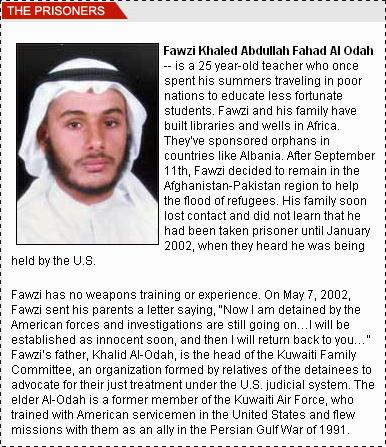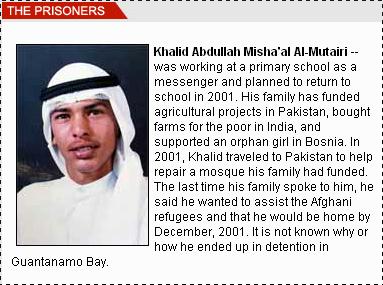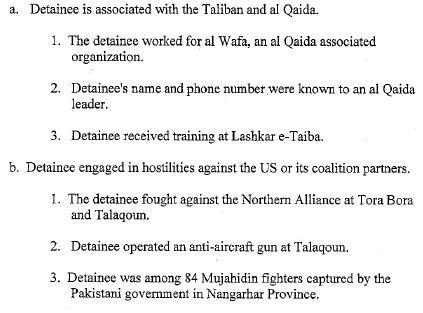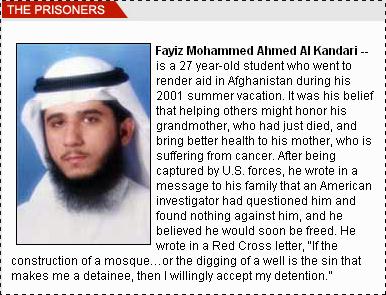With good reason, the United States government continues to classify Khalid Nijer Naser Al-Mutairi and Adil Zamil Abdull Mohssin Al Zamil as unlawful combatants, despite their release to the Kuwaiti government. The public relations campaign waged on their behalf fails to say what their Combatant Status Review Tribunals discovered about them. Let’s take a brief look at these two.
The PR for Khalid Nijer Naser Al-Mutairi:
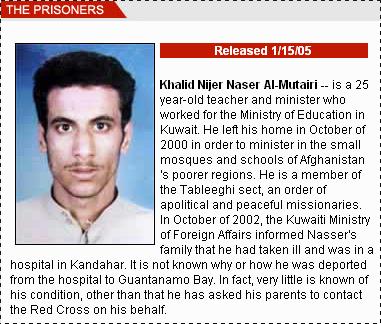
An excerpt from Khalid Nijer Naser Al-Mutairi’s CSRT:
The Recorder presented Exhibit R-1, the Unclassified Summary of Evidence, during the unclassified portion of the Tribunal. It indicates the detainee admitted to affiliation with the Taliban and admitted to traveling to Afghanistan to fight with the Taliban. It states he received weapons training in the use of hand grenades and the Kalashanikov rifle on the Karabatt line in Afghanistan. The Unclassified Summary of Evidence also asserts the detainee engaged in hostilities against the United States or its coalition partners. It states the detainee fought against North Alliance forces on the Karabatt line for six months and on the Kawajaqaar line for four months. The summary adds the detainee carried a Kalashnikov rifle and two grenades while on the front lines, and relinquished his weapon and surrendered to Northern Alliance forces at Mazar e-Sharif. Finally, the summary indicates the detainee was injured in the Qala-I-Jenghi prison uprising and eventually surrendered to Northern Alliance forces.
Learn more about the uprising at Qala-I-Janghi by clicking here.
The PR for Adil Zamil Abdull Mohssin Al Zamil:

An excerpt from Adil Zamil Abdull Mohssin Al Zamil’s CSRT:
The unclassified evidence presented to the Tribunal by the Recorder indicated that the detainee admitted establishing the al-Wafa organization in Kabul, Herat, and Kandahar, Afghanistan. The al-Wafa organization is listed on Executive Order 13224 as an entity that commits or poses a significant risk of committing acts of terrorism. The evidence also showed that the detainee was closely associated with Suliman Abu Ghaith, a spokesman for al Qalda and Usama Bin Laden. The detainee chose to participate in the Tribunal process. He called no witnesses and requested no documents be produced, but made an oral, sworn statement. The detainee, in his oral statement, admitted being affiliated with al-Wafa, but claimed he was just an employee. He also denied knowing that al Wafa had any connection with terrorism.
Read more about Sulaiman Abu Ghaith by clicking here.
What the PR campaign does not say about the “Kuwaiti 12,” says a lot about those who were hired to represent them.
Today, in the Wall Street Journal, Rohan S. Weerasinghe, senior partner of Shearman & Sterling LLP, says:
“…we did not hire the public relations firm Ms. Burlingame criticizes…”
While Mr. Weerasinghe does not explain whom he refers to when he says “we,” a public relations firm was hired and advised:
“In 2002, relatives of the Kuwaiti detainees, led by an impressive gentleman named Khalid Al-Odah, whose son remains among the detainees, banded together to form the Kuwaiti Family Committee. The group hired the large New York-based law firm Shearman & Sterling to spearhead the battle to grant these prisoners the legal protections provided to U.S. citizens, such as the right to have charges brought against them and the right to a trial.
“To create an environment where reporters knew that this issue deserved open-minded coverage, we devised a two-tiered PR strategy. One tack was to put a human face on the then “invisible” detainees in Guantánamo…”
Apparently, another tack used was to make invisible to the public the facts about the unlawful combatants they presented. That is what is known as spin.
It should also be noted that the Kuwaiti government has acknowledged it is the one paying the lawyers representing the “Kuwaiti 12.”

